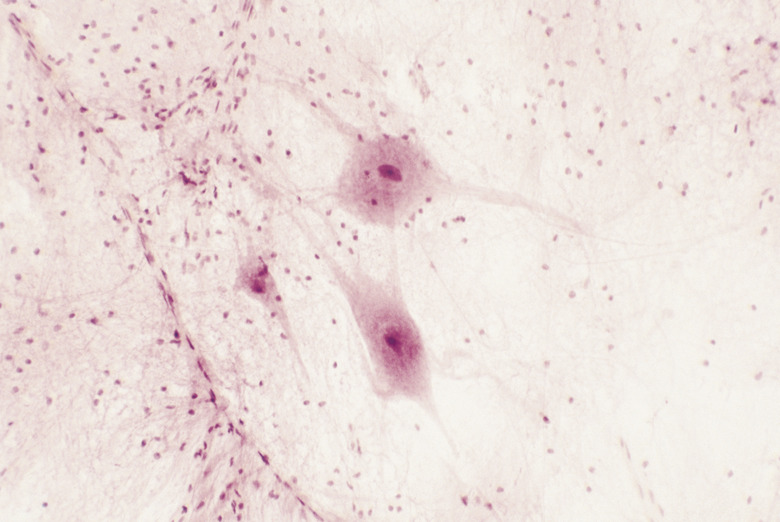What Is The Fluid That Fills The Space Between The Nucleus & The Cell Membrane?
The amazing human body contains up to 40 trillion cells of varying sizes and shapes, according to a 2017 article on the Medical News Today website. Living cells function like miniature factories with all parts contributing to the whole.
The nucleus is the boss directing all operations of the cell. Cytosol – the fluid between the nuclear envelope and the cell membrane – helps internal organelles do their job on the production floor. Water is a major component of cells, and intracellular fluid levels must be carefully regulated or the cell cannot work properly.
Cytoplasm and Cytosol
The cytoplasm is a gelatinous substance within the cell made up of organelles (other than the nucleus) and semi-fluid cytosol. The cytoplasm is a crowded place with lots of action going on.
Organelles such as the mitochondria, endoplasmic reticulum and the Golgi apparatus play specialized roles that keep the cell alive. Molecules constantly shuffle between organelles, proteins are synthesized, ATP energy currency is produced and waste discarded.
According to The Human Protein Atlas, cytosol is mostly water along with dissolved proteins, salts, glycogen, pigments and waste products. Many critical metabolic functions occur in cytosol, including glycolysis, transmission of chemical signals and intracellular movement of molecules.
Ions in cytosol regulate osmosis to keep the cell from swelling with water and bursting. Osmosis also works to retain sufficient water levels so the cell doesn't dry up or malfunction.
The cytoskeleton is comprised of protein fibers that provide scaffolding for organelles suspended in the cytoplasm. Microfilaments and microtubules in the cytoskeleton play a role in moving substances in and out of the cell. Microtubules assist with movement of the chromosomes during cell division.
Perfect orchestration is required because errors can result in chromosomal abnormalities, mutations and uncontrolled growth or tumors.
What Does the Nucleus Do?
Eukaryotic cells have a prominent nucleus with DNA encased inside it. The nucleus also contains a structure called the nucleolus, which is where ribosomes are made. Nuclear DNA determines inherited characteristics and gene expression.
The nucleus acts as control center signaling the cell when to grow, rest or propagate. For protective purposes, the nucleus is located in the middle of the cell rather than located near the membrane.
Nucleoplasm is the fluid inside the nucleus that contains ions, dissolved nucleotides and other chemicals essential to cell growth. Most eukaryotic cells have one nucleus, but there are exceptions.
For instance, maturing red blood cells dump their nuclei to hold more oxygen. Although not true cells by definition, the fused cells of skeletal muscle fibers have multiple nuclei that share cytoplasm.
What Is the Nuclear Membrane?
The inner and outer layers of the nuclear membrane form a nuclear envelope around the nucleus. Much of the space inside the nuclear envelope is filled with nuclear DNA, protein and nucleoplasm.
Nuclear pores within the nuclear envelope function as gatekeepers, selectively determining which kinds of molecules are allowed to pass back and forth from the nucleus to the cytoplasm.
The nuclear membrane maintains separation between the nucleoplasm and cytosol. The nucleus is surrounded by nucleoplasm. During cell division, the nuclear membrane dissolves to make room for the separating chromosomes migrating to opposite poles of the cell. The nuclear membrane forms again after cells split and DNA condenses in the nucleus.
What Is the Cell Membrane?
The phospholipid cell membrane prevents essential proteins, carbohydrates, ATP and nucleic acids from seeping out of the cell. Molecules are filtered by size, type and polarity. The outer layer of the cell membrane is hydrophilic and the inner layer is hydrophobic.
Simply stated, the outer layer of the cell membrane is friendly to water-soluble molecules, whereas the outer layer limits diffusion of water-soluble molecules such as sodium and calcium ions that are needed in the cell.
References
Cite This Article
MLA
Dowd, Mary. "What Is The Fluid That Fills The Space Between The Nucleus & The Cell Membrane?" sciencing.com, https://www.sciencing.com/fluid-fills-space-between-nucleus-cell-membrane-21545/. 5 April 2019.
APA
Dowd, Mary. (2019, April 5). What Is The Fluid That Fills The Space Between The Nucleus & The Cell Membrane?. sciencing.com. Retrieved from https://www.sciencing.com/fluid-fills-space-between-nucleus-cell-membrane-21545/
Chicago
Dowd, Mary. What Is The Fluid That Fills The Space Between The Nucleus & The Cell Membrane? last modified August 30, 2022. https://www.sciencing.com/fluid-fills-space-between-nucleus-cell-membrane-21545/
